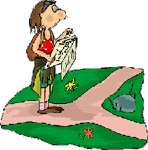|
 TYPES OF MAPS TYPES OF MAPS
Teacher Outline
* Teacher Outline included in Teacher
Guide Download
I. What is a map?
- Usually a flat representation of an area of the Earth
(or Moon, etc). Contains information about an area.
- How is a map similar to or different than a
photograph of an area? A map uses symbols to highlight area and makes human
created and natural features more distinct
II. Type of maps. Show examples.
- Road maps, topographic maps, geologic maps,
historical maps, bus route maps, climate maps, population density maps, land
use maps, and many more.
- Use different maps for different purposes. You donít
use your spelling book to learn about fractions, and you donít use your math
book to learn about U.S. history. A topographic map helps show relief and a
city map shows roads. You would not use a city map to determine the relief.
III. Maps are like books - we learn how to
read them.
- Maps are written in a language of symbols. We
only need to learn the language. The letters and words in a book are a type
symbols.
- Parts of a book: Title page, table of contents, index,
glossary. Maps have analogous parts. Instead of this information beginning on
extra pages in the front and back of the book, maps have all this information
printed in the margins.
- The legend (or explanation, or key) on a map is like
the glossary in a book.
IV. Directions (which way?)
- North, east, south, west are the four cardinal
directions.
- How do we find directions in the real world? (without
a map)
- Compass
- Sun and shadows
- Stars
- Directions on a map.
- Look for north arrow
- North is usually at the top of a map, especially if there is no arrow
showing another direction
V. Distance and Scale
- A scale is a relationship of sizes. Distances on the
map to distances in the real world are expressed in a ratio.
- Maps are usually smaller than the area they
represent. Not very convenient to carry around the city map the same size as
the city.
- Three ways to express scale.
- In words: I inch = 1 mile
- A bar scale:
- A ratio: 1:24,000. Although this is sometimes the most difficult one to
understand, it can be the most useful. It tells us exactly how much all the
measurements in the real world were "shrunk down," to fit the map.
It also has no units; itís valid whether you are measuring in inches,
miles, meters, or anything else.
VI. Map Projections
- Earth is spherical, like a glove. Maps are flat. What
problems arise in representing a round world on a flat piece of paper?
- Imagine trying to get an orange peel (or even half of
one) to lay flat on a table. It canít be done without tearing or stretching
parts of the peel. This is exactly what map makers do when depicting the
Earth. There are various ways we can do this.
- Examples of projections (just a few examples)
- Mercator - Used for navigation or maps of
equatorial regions. Distances are only true along Equator, but are
reasonably correct within 15ļ of Equator. Distortion increases from north
and south of the Equator.
- Gnomonic - Used along with the Mercator by
navigators to find the shortest path between two points. Considered to be
the oldest projection. Ascribed to Thales, the father of abstract geometry
who lived in the 6th century B.C.
- Azimuthal Equidistant - Useful in showing airline
distances from center point of projection. Distances and directions to all
places true only from center point of projection.
- Albers Equal Area Conic - Shows maps for the
conterminous United States. All areas on the map are proportional to the
same areas on the Earth.
- Lambert Conformal Conic - Used by U.S. Geological
Survey for many 7.5 minute topographic maps and for the State Base Map
series. Distances true only along standard parallels.
- We donít have as much of a problem with maps
covering only a small area. (Itís easy to get a small piece of the orange
peel to lay flat. If an orange was a globe!)
- Reconstructing different projections.
VII. Topography and Topographic (Topo)
Maps
- How do we show a 3 dimensional world on a 2
dimensional piece of paper? Show exact shape of land, elevation, etc.
- Contour lines
- "Connect the dots" of equal lines of
elevation.
- If you were walking and following the same path as a contour line, you
would not be walking uphill, nor downhill, but perfectly level.
- Bath tub ring analog. The water flows out in equal lines of elevation.
- Old shore lines showing water levels as a lake dries up. Always horizontal.
- How to read a topo map: What do steep cliffs, rolling
hills, river valleys, flat lands, etc. Look like on the map?
|